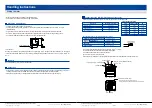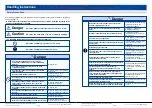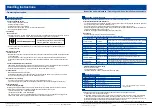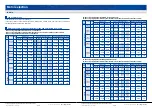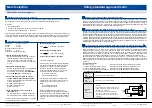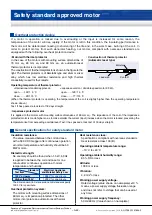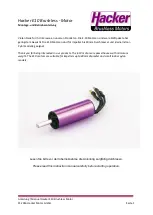
– A-58 –
Panasonic Corporation Electromechanical Control Business Division
industrial.panasonic.com/ac/e/
©
Panasonic Corporation 2018
AQCTB02E 201806-E
– A-59 –
Panasonic Corporation Electromechanical Control Business Division
industrial.panasonic.com/ac/e/
©
Panasonic Corporation 2018
AQCTB02E 201806-E
Safety standard approved motor
Calculation of motor capacity
Motor selection
6. Measurement of motor with gear head
When a motor alone is coupled to equipment, the speed is measured at output shaft section using a strobe light
etc. In the case of a motor with a gear head, the speed is calculated from the following formula.
n = i
x
n
1
n
: Motor speed
(r/min)
n
1
: Speed of gear output shaft or pulley etc. attached to it
(r/min)
i
: Reduction ratio of gear head (e.g. i = 30 for 1/30)
When measuring the speed of a gear output shaft having a large reduction ratio, do not measure the number of
revolutions per minute, but measure the time taken for the gear output shaft to rotate 100 turns using a stopwatch
after putting a mark on the shaft. Then calculate the number of revolutions per minute from the measured time.
Domestic and overseas standards approved motors
For motors sold domestically or exported abroad, it is necessary to ensure the safety against “Fire, electric shock
and injury” that meets the corresponding standards of each country. Among such standards are the Electrical
Appliance and Material Safety Law in Japan, the UL standard in the North American market, the CE marking in
the European market and the CCC marking in the Chinese market. We also provide products meeting these
safety standards. The descriptions of these standards are shown below.
Electrical Appliance and Material Safety Law (domestic law in Japan)
This law is a domestic law in Japan intended to regulate the manufacture, sale, etc. of electrical appliances and
to prevent the occurrence of fire, electric shock, injury, etc. attributable to electrical appliances by promoting self-
activities of private enterprises for ensuring the safety of electrical appliances. Among the contents of the regula-
tion are obligations of submission of manufacturing (export) business, conformance to technical standards and
indication. Electrical appliances are classified into two groups: specific electrical appliances (equivalent to ko-type
in the former law) and electrical appliances other than specific electrical appliances (otsu-type in the former law).
On motors (electrical appliances other than specific electrical appliances) regulated by this law, a PSE mark is
indicated and descriptions based on this law are shown.
UL (CSA) Standard (to be considered when exporting motors to North America)
This standard was established by the fire insurance company association in the United States of America. Like
Japan, low voltage (115 V, 60 Hz) is used in this region, and measures against fire in particular are strongly
required. Insulators used for UL-approved products are made of UL-approved incombustible materials. In
addition, installation of an overheat protection device is required. In the case of motors with mounting surface
dimensions of 70 mm sq., 80 mm sq. and 90 mm sq., an automatic-reset thermal protector is incorporated. In the
case of motors with mounting surface dimensions of 60 mm sq., impedance protected motor design is used.
The CSA standard is a necessary requirement for exporting to Canada. It is possible to put a c-UL mark on
products inspected and approved by UL in accordance with the CSA standard in addition to the UL standard.
Products bearing this c-UL mark are regarded as products conforming to CSA standard and therefore can be sold
in Canada.
• UL standard on motor
UL1004-1 (motor)
: Provisions concerning motor construction and material
UL1004-2 (thermal protection of motor)
: Provisions concerning impedance protection of motor
UL1004-3 (thermal protection of motor)
: Provisions concerning thermal protection of motor
UL840 (insulation coordination of equipment) : Provisions concerning base items of motor insulation
7. Example of motor selection
Application
: Driving of conveyor
Voltage
: 100 V
Speed
: 30 r/min
Working condition : Continuous
Frequency
: 60 Hz
Select a motor that meet the above.
(1) Speed suitable for specifications
Because the required speed is 30 r/min, the gear
ratio that realizes a rated motor speed (60 Hz
area) of 1500 r/min to 1550 r/min is 1500/30 to
1550/30 = 50 to 51.67. Therefore use a gear ratio
of 1/50.
(2) Calculation of required torque
Measure the approximate load with a spring balance
etc. Assume that it is
2.65 N·m (375.27 oz-in)
.
After referring to our catalog, select M81X25G4L
and install MXBG50B as a reduction gear.
(3) Actual measurement of minimum starting
voltage, minimum stable voltage and speed
Assume that the following are obtained as a result
of actual measurement.
Minimum starting voltage: 75 V
Minimum stable voltage: 55 V
Speed: 1700 r/min
(4) From speed-torque curve of 4-pole 25 W
induction motor
Ts
: Starting torque
Ts = 0.16 N·m (22.66 oz-in)
Tm
: Stalling torque
Tm = 0.25 N·m (35.4 oz-in)
The torque is proportional to the square of the voltage
and the following values are obtained.
(Minimum starting torque)
0.16
x
( )
2
= 9
x
10
–2
N·m (12.75 oz-in)
(Minimum required stalling torque)
0.25
x
( )
2
= 7
x
10
–2
N·m (9.91 oz-in)
(Torque at motor speed of 1700 r/min)
= 0.12 N·m (16.99 oz-in)
From the above, it can be seen that this application
is a constant torque load and that the 4-pole 25 W
induction motor still has a more than sufficient
capacity. In addition, as is evident from the S-T
curve of the attached S-T data, Ts and Tm of the
4-pole 15 W induction motor are as follows:
Ts = 0.1 N·m (14.16 oz-in)
Tm = 0.15 N·m (21.24 oz-in)
Considering the voltage drop and variation when
used for conveyors, Ts and Tm of the 4-pole 15 W
induction motor at 90 V are assumed to be as
follows:
Ts = 0.08 N·m (11.33 oz-in)
Tm = 0.12 N·m (16.99 oz-in)
When the voltage drop and variation or load
variation is thought to be insignificant, the 4-pole 15
W induction motor and gear head MX7G50B can be
used. When the voltage variation or load variation is
significant, the 4-pole 25 W induction motor should
be used.
75
100
55
100
• Conformance to UL and CSA
• UL1004-1
• CSA
C22.2 No.100
All products conform to these standards.
• UL1004-2
• CSA
C22.2 No.77
6 W motors conform to these standards.
• UL1004-3
• CSA
C22.2 No.77
· Single-phase 2-pole motors conform to these
standards.
· These standards do not apply to single-phase 15
to 90 W 4-pole motors wired as shown in wiring
diagrams on pp. A-60 to A-61.
For example, when the thermal protector is
connected in series between power line and
motor white terminal (U1), this circuit becomes
compatible.
· These standards do not apply to 3-phase motors.
Single-
phase
power
source
MCCB
Motor
Thermal protector
White (U1)
Gray (U2)
Black (Z2)
Capacitor
Blue (P)
Blue (P)






